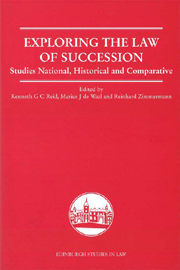Book contents
- Frontmatter
- Contents
- Preface
- List of Contributors
- List of Abbreviations
- Table of Cases
- 1 A Comparative Overview
- 2 Compulsory Heirship in Roman Law
- 3 Succession Law in Scotland – a Historical Perspective
- 4 Succession Law in South Africa – a Historical Perspective
- 5 Freedom of Testation and the Ageing Testator
- 6 Testamentary Conditions and Public Policy
- 7 Forfeiture Clauses and Events in Scots Law
- 8 Revocation of Wills by Changed Circumstances
- 9 Fideicommissary Substitutions: Scots Law in Historical and Comparative Perspective
- 10 The conditio si institutus sine liberis decesserit in Scots and South African Law
- 11 The New Dutch Law of Succession
- 12 Revocability of Mutual Wills
- 13 Succession Agreements in South African and Scots Law
- Index
11 - The New Dutch Law of Succession
Published online by Cambridge University Press: 12 September 2012
- Frontmatter
- Contents
- Preface
- List of Contributors
- List of Abbreviations
- Table of Cases
- 1 A Comparative Overview
- 2 Compulsory Heirship in Roman Law
- 3 Succession Law in Scotland – a Historical Perspective
- 4 Succession Law in South Africa – a Historical Perspective
- 5 Freedom of Testation and the Ageing Testator
- 6 Testamentary Conditions and Public Policy
- 7 Forfeiture Clauses and Events in Scots Law
- 8 Revocation of Wills by Changed Circumstances
- 9 Fideicommissary Substitutions: Scots Law in Historical and Comparative Perspective
- 10 The conditio si institutus sine liberis decesserit in Scots and South African Law
- 11 The New Dutch Law of Succession
- 12 Revocability of Mutual Wills
- 13 Succession Agreements in South African and Scots Law
- Index
Summary
THE NEW LAW IN OUTLINE
Introduction
On 1 January 2003, after a long period of reflection and parliamentary debate, the new Dutch law of succession entered into force as Book 4 of the Civil Code. It was accompanied by the new law on gifts in Book 7 (Special Contracts). As can be seen from the legislative history, it took more than thirty years after the enactment of Book 4 before the new law could enter into force. Particular controversy had surrounded the position of the surviving spouse and children, especially in a situation where the surviving spouse remarries and the new husband or wife also has children.
This chapter outlines the new law of succession, both testate and intestate, focusing on the rights of the surviving spouse and children. It then sets the basic features of the new law against the general part on property law in the new Civil Code, and considers these from the perspective of comparative legal analysis. It is necessary to begin, however, with a few introductory remarks on Dutch matrimonial property law because, as is well known, the law of succession and matrimonial property law are closely interrelated.
Matrimonial property law
The Netherlands is one of the very few countries left that still knows total community of property if no marriage settlement has been concluded. Under total community of property, everything that the spouses owned from before the marriage, and their debts, become common.
- Type
- Chapter
- Information
- Exploring the Law of SuccessionStudies National Historical and Comparative, pp. 193 - 207Publisher: Edinburgh University PressPrint publication year: 2007

